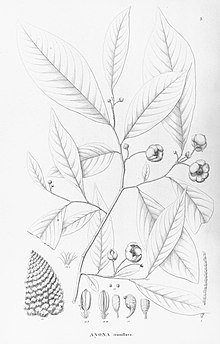Annona tenuiflora
| Annona tenuiflora | |
|---|---|

| |
| Botanical illustration of Annona tenuiflora | |
| Scientific classification | |
| Kingdom: | Plantae |
| Clade: | Tracheophytes |
| Clade: | Angiosperms |
| Clade: | Magnoliids |
| Order: | Magnoliales |
| Family: | Annonaceae |
| Genus: | Annona |
| Species: | A. tenuiflora
|
| Binomial name | |
| Annona tenuiflora | |
| Synonyms | |
|
Raimondia tenuiflora (Mart.) R.E.Fr. | |
Annona tenuiflora is a species of plant in the family Annonaceae. It is native to Brazil, Colombia, French Guiana and Venezuela.[2] Carl Friedrich Philipp von Martius, the German botanist who first formally described the species, named it after the slender (tenui- in Latin) sepals and petals of its flowers.[3][4]
Description
It is a tree that reaches greater than 9.75 meters in height. Its leaves are 5.4-27 centimeters by 2.7-10.8 and have rounded tips. The leaves have a reddish underside and slightly wavy margins. Its peduncles are 2.7 - 4.1 centimeters long. Carl von Martius conjectured that it has male and female flowers. Its sepals are 2.25 millimeters long. Its flowers have 6 petals in two rows of three. Its pink, concave, oval petals are 1.8 centimeters long. It has numerous tightly packed stamens with hairs at their base, arranged on a conical receptacle. Its anthers are pink.[4]
Reproductive biology
The pollen of A. tenuiflora is shed as permanent tetrads.[5]
Habitat and distribution
It has been observed in woodland habitats.[4]
Uses
It has been reported to be used to treat headache, dizziness and hypotension.[6]
References
- . Retrieved 20 June 2022.
- ^ "Annona tenuiflora Mart". Plants of the World Online. The Trustees of the Royal Botanic Gardens, Kew. n.d. Retrieved January 5, 2019.
- ISBN 9780881926279.
- ^ a b c von Martius, Carl Friedrich Philipp (1841). "Anonaceae". Flora Brasiliensis (in Latin). Vol. 13. Munich & Leipzig: R. Oldenbourg. p. 13.
- JSTOR 41764703.
- ISBN 978-85-61890-88-9.

